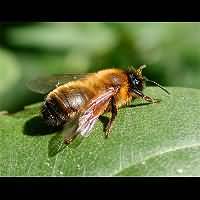Andrena nigroaenea
Andrena nigroaenea is quite a big mining bee, even looking bigger than it actually is, for it is quite plump. Yet it is scarcely 14 mm in length. The thorax has brownish hairs, just like in the species above, but the colour is significantly darker. The abdomen has hairs in the same colour, but the tail is covered with black hairs. This species is clearly less abundant than the Tawny Mining Bee for instance. More so, for the females nest alone. In suitable territories females may nest together, but there always is a substantial distance between individual nests. Both males and females can be seen from the beginning of April till mid-June, though males have usually disappeared by the end of May. The females spread a very strong pheromone, which attracts the eager males. Recent studies have shown the females produce another type of pheromone once being inseminated. Males show no interest in these females anymore. An orchid, the Early Spider Orchid (Ophris sphegodes) takes advantage of this fact. Like all other orchids it doesn't produce any nectar and therefore is of no interest to insects. Still it needs insects for its own reproduction. So it produces a pheromone identical to that of Andrena nigroaenea. And what is more the flowers are hairy and have the same feel as a female mining bee. This attracts many males, ready to mate. They go through the flower several times, looking for the supposed ready female, but end up empty handed and full of the orchids pollen. Fully disappointed they leave the flower, only to be attracted by the next one. This way the frustrated males are taking care of the orchids reproduction. In Britain however this is no problem for our bee, for the Early Spider Orchid is either absent or extremely rare (we are not absolutely sure of the plant's status in Southern England, but in all other parts of Britain it is absent). Andrena nigroaenea also visits the flowers of many early blooming plants, preferring Dandelions and various willows. We do not know anything about its abundancy in the UK and Ireland.
Andrena nigroaenea is quite a big mining bee, even looking bigger than it actually is, for it is quite plump. Yet it is scarcely 14 mm in length. The thorax has brownish hairs, just like in the species above, but the colour is significantly darker. The abdomen has hairs in the same colour, but the tail is covered with black hairs. This species is clearly less abundant than the Tawny Mining Bee for instance. More so, for the females nest alone. In suitable territories females may nest together, but there always is a substantial distance between individual nests. Both males and females can be seen from the beginning of April till mid-June, though males have usually disappeared by the end of May. The females spread a very strong pheromone, which attracts the eager males. Recent studies have shown the females produce another type of pheromone once being inseminated. Males show no interest in these females anymore. An orchid, the Early Spider Orchid (Ophris sphegodes) takes advantage of this fact. Like all other orchids it doesn't produce any nectar and therefore is of no interest to insects. Still it needs insects for its own reproduction. So it produces a pheromone identical to that of Andrena nigroaenea. And what is more the flowers are hairy and have the same feel as a female mining bee. This attracts many males, ready to mate. They go through the flower several times, looking for the supposed ready female, but end up empty handed and full of the orchids pollen. Fully disappointed they leave the flower, only to be attracted by the next one. This way the frustrated males are taking care of the orchids reproduction. In Britain however this is no problem for our bee, for the Early Spider Orchid is either absent or extremely rare (we are not absolutely sure of the plant's status in Southern England, but in all other parts of Britain it is absent). Andrena nigroaenea also visits the flowers of many early blooming plants, preferring Dandelions and various willows. We do not know anything about its abundancy in the UK and Ireland.




